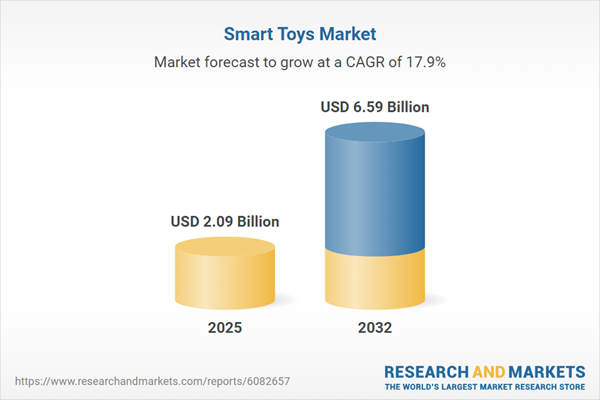Speak directly to the analyst to clarify any post sales queries you may have.
The smart toys market is rapidly evolving as digital innovation transforms interactive play, catering to higher consumer expectations in educational and recreational settings. Senior decision-makers are seeking targeted market intelligence to support strategic, sustainable investment and respond effectively to shifting regulatory and technological trends.
Market Snapshot: Smart Toys Market Growth and Dynamics
The Smart Toys Market expanded from USD 1.77 billion in 2024 to USD 2.09 billion in 2025, and is projected to increase at a CAGR of 17.85%, reaching USD 6.59 billion by 2032. Heightened demand for digital connectivity drives consistent market momentum, enriching education and play through cutting-edge technologies. Artificial intelligence, augmented and virtual reality, and programmable systems are increasing engagement across all age groups. The market's evolution fosters growth opportunities through product innovation, broader partnerships, and new routes to emerging global channels, establishing a strong platform for forward-looking stakeholders.
Scope & Segmentation: Smart Toys Landscape Defined
This report delivers a structured, comprehensive view of the smart toys sector. Coverage spans product types, demographic focus, key technology adoption, channel diversity, geographic breakdowns, and leading company roles, supporting decision-makers in building robust strategies.
- Product Types: AR and VR-enabled toys, programming instruction kits, interactive learning solutions, plush designs with advanced interactivity, and robotics-based play options for various developmental stages.
- Age Groups: Products segmented for early childhood (0-3 years), preschool and primary (4-7 years), pre-adolescents (8-12 years), and teenagers and older (13+), aligning educational content and safety features by age bracket.
- Technologies: Solutions integrate artificial intelligence for customized interaction, facial and voice recognition for enhanced safety and personalization, seamless device connectivity, and AR/VR overlays to blend physical and digital play. Sophisticated robotics deliver advanced functions and enable STEM learning.
- Distribution Channels: Mass retail outlets, direct-to-consumer and partner e-commerce platforms, specialty toy distributors, as well as mature brick-and-mortar storefronts, strengthening reach across diverse buyer profiles.
- Regions: Detailed analysis covers the Americas (North and South America), EMEA (incorporating established and emerging economies across Europe, Middle East, and Africa), and Asia-Pacific (including China, Japan, India, Australia, and Southeast Asia), each presenting distinct adoption trends, regulatory factors, and market-entry challenges.
- Key Companies: Includes industry leaders such as LEGO System A/S, Hasbro, Mattel, Spin Master, VTech Holdings, TOMY Company, JAKKS Pacific, UBTECH Robotics, WowWee Group, and Sphero, noted for innovation, market leadership, and strategic partnerships.
Key Takeaways: Strategic Insights for Senior Decision-Makers
- AI and machine learning empower toys to adapt and personalize interactions, supporting user engagement and enabling varied learning outcomes in both formal and informal settings.
- AR and VR features extend the value of traditional play, while coding kits drive early interest in technical skills and support curriculum integration for STEM education.
- Market segmentation by age group allows manufacturers to address unique educational and safety priorities, facilitating compliance with diverse regulatory frameworks and building consumer confidence.
- Collaboration between toy companies, technology partners, and education specialists accelerates innovation and expands product pipelines, aligning with institutional purchasing priorities as well as consumer demand.
- Sustainable design practices, such as modular construction and environmentally friendly materials, are increasingly central in response to both regulatory pressure and consumer demand for responsible manufacturing in the toy sector.
- Brand strategies now prioritize secure, connected ecosystems blending physical products with digital platforms and robust privacy measures to safeguard user data while enhancing user experience.
Tariff Impact: Navigating the 2025 U.S. Trade Measures
New tariffs on electronic components are reshaping supply dynamics for smart toy providers. Many organizations are diversifying supply networks by evaluating local procurement options and refining purchasing strategies to drive efficiency. These pressures often spur new product differentiation focused on innovative features, helping producers shift away from price-led competition. Upstream impacts extend to retailer partnerships and logistics, particularly affecting premium brands operating across multiple channels.
Methodology & Data Sources
Findings in this report originate from a multi-stage process, including analysis of secondary market data, interviews with industry experts, and comprehensive quantitative end-user surveys. Results are cross-referenced with established benchmarks to ensure accuracy and depth.
Why This Report Matters: Strategic Value for Smart Toys Market Leaders
- Identifies actionable frameworks for segment-driven expansion, guiding new product development and operational optimization.
- Delivers timely market intelligence on innovation pathways, compliance shifts, and the evolution of distribution strategies.
- Enables benchmarking for sustainability, digital integration, and data security initiatives, supporting leadership in a competitive market environment.
Conclusion
For stakeholders aiming to advance connected play and learning in alignment with sustainability, this analysis delivers strategic insight and position-building guidance. Leveraging these findings supports market resilience and long-term value creation in an evolving sector.
Table of Contents
3. Executive Summary
4. Market Overview
7. Cumulative Impact of Artificial Intelligence 2025
Companies Mentioned
The companies profiled in this Smart Toys market report include:- LEGO System A/S
- Hasbro, Inc.
- Mattel, Inc.
- Spin Master Corp.
- VTech Holdings Limited
- TOMY Company, Ltd.
- JAKKS Pacific, Inc.
- UBTECH Robotics Corp.
- WowWee Group Limited
- Sphero, Inc.
Table Information
| Report Attribute | Details |
|---|---|
| No. of Pages | 183 |
| Published | October 2025 |
| Forecast Period | 2025 - 2032 |
| Estimated Market Value ( USD | $ 2.09 Billion |
| Forecasted Market Value ( USD | $ 6.59 Billion |
| Compound Annual Growth Rate | 17.8% |
| Regions Covered | Global |
| No. of Companies Mentioned | 11 |









